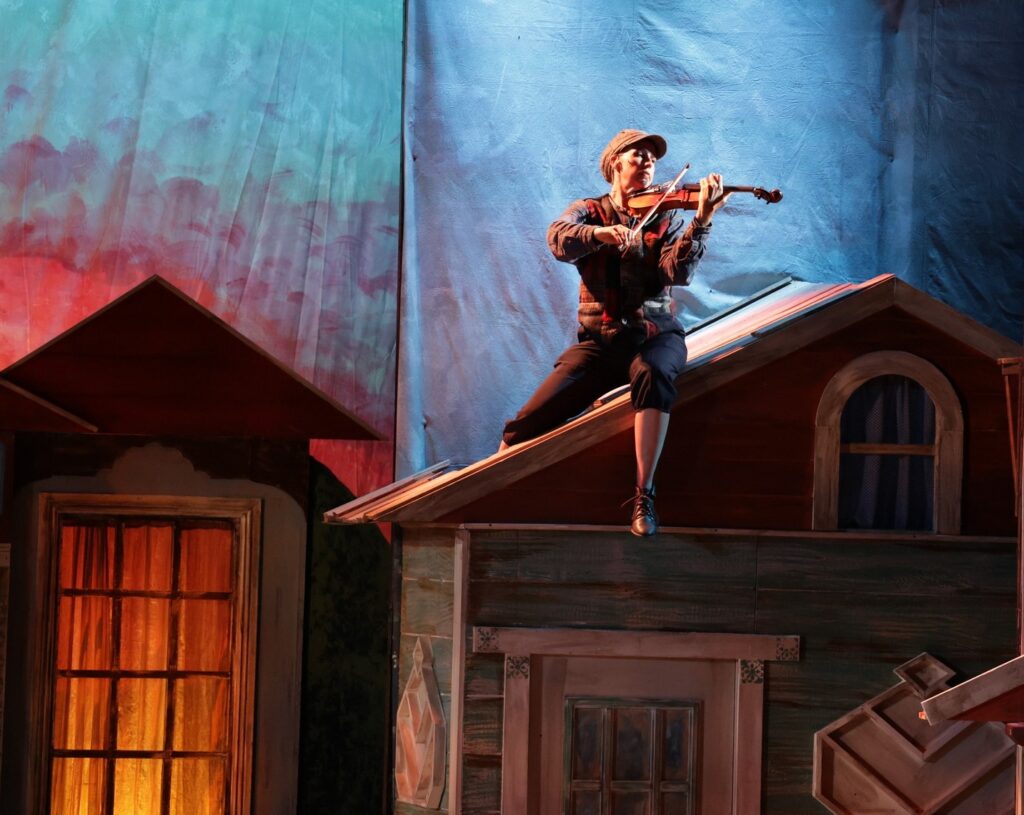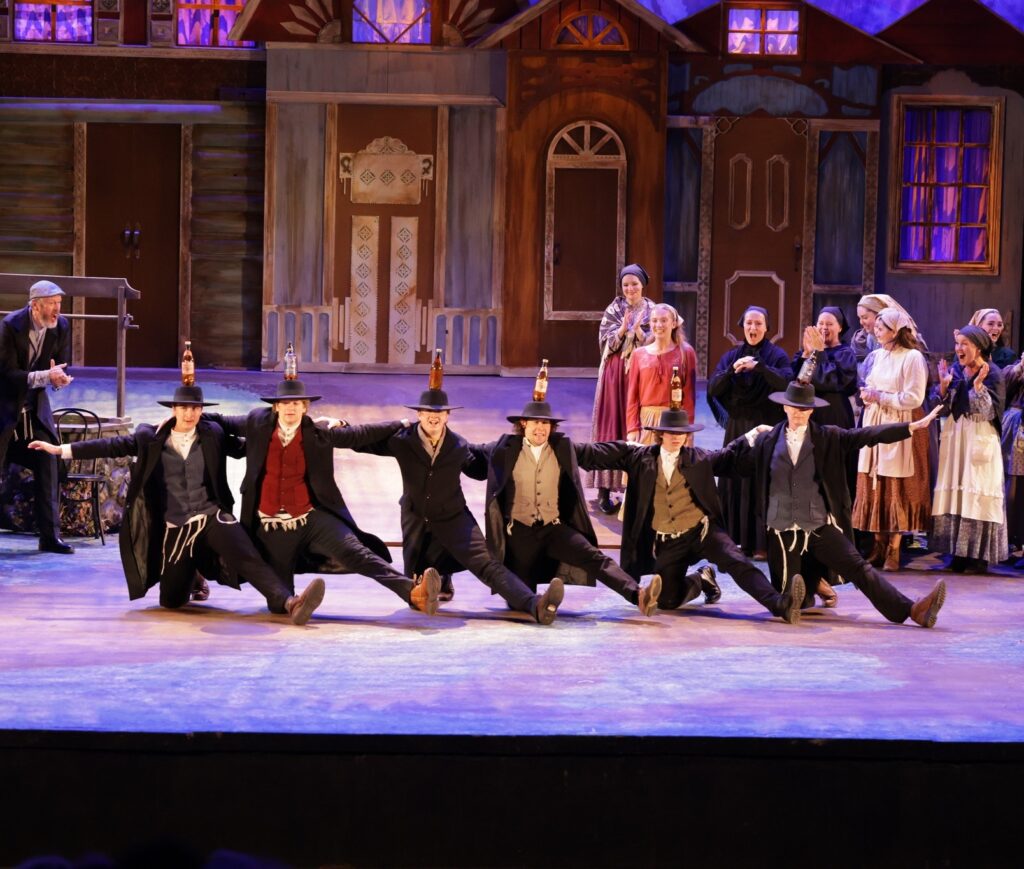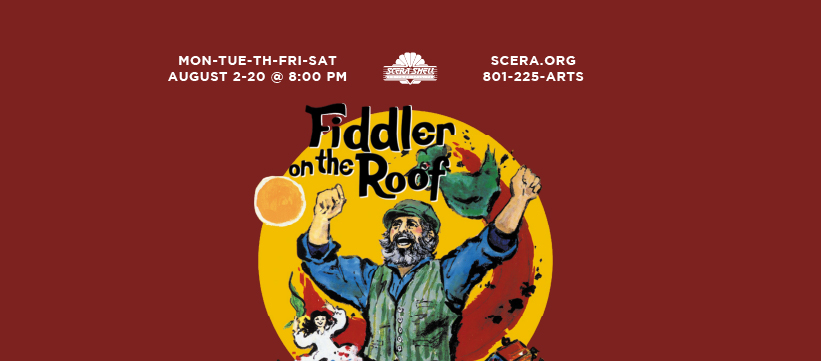OREM — Fiddler on the Roof is a golden age classic and a cherished favorite within the Utah community. The themes of love, community, and inevitable change found new life as the sun set over this beautiful outdoor production at the Scera Shell.
Written by Joseph Stein with music by Jerry Brock and lyrics by Sheldon Harnick, Fiddler on the Roof explores how Tevye, a Jewish milkman, and his family seek to balance tradition and change as their community faces difficulties at the hands of Imperial Russia at the turn of the 20th century.
The show is carried by Tevye, which is a large task for any actor, and Andrew Lambert was up to the challenge. Lambert quickly established a wonderful rapport with the audience, expertly displaying a mix of humor and a deep love for his family and traditions. Each of his monologues to the audience was an absolute pleasure, and his rich vocals were a highlight in his solo “If I Were a Rich Man.” Tevye’s jovial nature provided good contrast to his commanding and down-to-earth wife, Golde (played by Shani Harper). Harper displayed a lovely classical voice, especially catching my notice during the song “Sabbath Prayer.” She found a wonderful balance between imposing matriarch and loving mother that brought depth to the character.
The three oldest daughters: Tzeitel, Hodel, and Chava (played by Emma Elison, Elisha Garrett, and Jenna Hart respectively) brought a youthful charm that matured wonderfully as the play progressed. Of the daughter’s relationships, the most compelling to me was between Hodel and Perchik (played by Ethan Kelso). Garrett and Kelso displayed wonderful chemistry in their shared dances during Act 1 and in “Now I Have Everything” (which also contained some fantastic vocals from Kelso). This relationship brought real feeling to Garrett’s beautiful rendition of “Far From the Home I Love.” Another highlight was Hart’s graceful dancing during the “Chava Ballet.” Golden age dream ballets have a potential for awkwardness, but this sequence (choreographed by Olivia Keating) felt well-motivated.

In this show that features themes of community, this large ensemble shined brightly. They showcased a strong and well-blended sound during group numbers such as “Tradition” and “Sabbath Prayer” (music direction by Christian Wawro). The ensemble was also involved in some lovely dance sequences, my personal favorites being “Tradition” and “To Life,” which featured an incredibly fun and energetic dance-off between the Jewish villagers and the Russians. This number also showed off the vocals of Nate Hart as Fyedka as he held some wildly impressive sustained notes. The number was filled with toe-touches, leaps, Russian dancing, and a whole lot of fun. A risk with complicated dancing is that sometimes it can get messy, and this production was not free of that. The dancing was not always clean or flawless, but it was constantly filled with high energy and lots of character.
“Lots of character” is where this ensemble excelled. Some of my favorite moments of the show were in small moments with featured actors. Highlights including: brilliant comedic intuition from Yente the Matchmaker, the Rabbi, and Grandma Tzeitel (played by Megan Christensen, Abraham Lee, and Elizabeth Thompson, respectively), and Kile Harper as an energetic and buoyant Lazar Wolf (a character I have never really liked, but found myself loving in this production). Other wonderful character moments from the ensemble were seen in “The Wedding” and “The Rumor.”
In both solo and group numbers, singers had occasional, slight challenges with the backing tracks (for example: coming in a moment early and needing to extend a note or needing to jump in quicker than expected). However, that is simply the struggle that comes with using tracks instead of live music, and the performers handled it expertly.

This production was filled with all around strong performances, and the direction and design of the show added another level. The set design (by Chase Ramsey) and scenic art was reminiscent of 20th century Russian art. Large set pieces, such as homes, were designed in a practical way that allowed for ease in transitioning between locations. The design focusing on their village, their home of Anatevka, brought emphasis to the focus on community. This was also aided by the stage pictures created by director Kurt Elison and assistant director Jennilene Ward, as seen in every group number in the show. This production highlighted the idea that even though we were viewing this story from the perspective of one family, the story is an exploration of a community and their changing way of life. This brought additional poignancy to the ending as the community is forced to separate.
One of the things that particularly stood out to me about this production compared to others I’ve seen was the feeling of hope. This musical deals with some heavy themes and dark moments, and this can often lead to a very depressing Act 2. However, this production carried a feeling of hope to the dark moments, while still being sure not to minimize those struggles.
With only a few performances left, the sun is setting on this production of Fiddler on the Roof at the Scera Shell. With a talented cast, beautiful design, and a timeless story, this is not a production to be missed. See it while you can!
[box]Fiddler on the Roof plays Mondays, Tuesdays, Thursdays, Fridays & Saturdays at 8:00pm at the Scera Shell (600 S 400 E, Orem) through August 20th. Tickets are $12-20. For more information, visit scera.org[/box]

